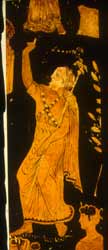Legends of Greece and their history
 Rhadamanthys, brother to King Minos of Knossos, on a 5th century vase. © Ekdotiki Athenon |
There are many Greek stories about a time before the classical period concerning the Aegean in general and Crete in particular, but they were considered under the heading of 'myths' (not history) and therefore not true. Many focus on a particular place, Knossos. This name was preserved in classical and later writings, and is still attached to the area south-east of modern Herakleion, about 5km from the sea. In these stories Minos was king of Knossos, and his brother Rhadamanthys was known as a great judge and law-giver.
Minos' wife PasiphaŽ fell passionately in love with a bull, and gave birth to the Minotaur, half human and half bull. Minos' architect Daedalus was asked to build a prison for the Minotaur, which had such a complicated plan that it was like a maze. This was the Labyrinth.
 Theseus killing the Minotaur, on an Athenian pottery cup, 5th century BC. Ashmolean Museum (inv. G.261; V.303). Courtesy of the Ashmolean Museum, University of Oxford. |
Minos exacted a regular tribute of seven girls and seven boys from Athens, who were fed to the Minotaur. This sad tribute stopped only when the Athenians sent the young Theseus as one of the seven boys. Minos' daughter Ariadne helped Theseus to find his way out of the Labyrinth by tying a piece of thread to the entrance door.
Theseus killed the Minotaur, escaped from the Labyrinth, and left Crete with Ariadne.
 The story of Icarus in four scenes. 1. the making of the wings by Daedalus; 2. Icarus tries on the wings; 3. Icarus flies; 4. Icarus dead. © Ekdotiki Athenon |
Later, Daedalus and his son Icarus were themselves imprisoned in the Labyrinth. They escaped by making wings out of feathers and wax, but Icarus flew too close to the sun and plunged to his death into the Aegean sea.
Later still, Cretans from various parts of the island including Knossos fought in the Trojan War.
This bundle of stories fits neatly into the fifth-century Greeks' view of their own past, which began with the creation of the world, followed by the age of heroes such as Theseus and the Trojan War. The Greeks considered that those returning from the Trojan War were their own ancestors. They held these stories to be true, and indeed historically true. It was other people later on who thought that the stories of Knossos were 'only myths'.
In the nineteenth century, people in the west thought that stories like those about Knossos had no historical basis whatsoever, and were indeed 'only myths'. Many people believed that the account of the world creation given in Genesis was literally true. The Greeks impinged on the Judaeo-Christian world in the Hellenistic period and became a definite part of it by the time of the New Testament, which was written in Greek. In the seventeenth century Bishop Ussher had determined that the world was created in 4004 BC, and there was certainly no obvious gap in his generally accepted account for anything earlier than the Classical period in the Aegean.